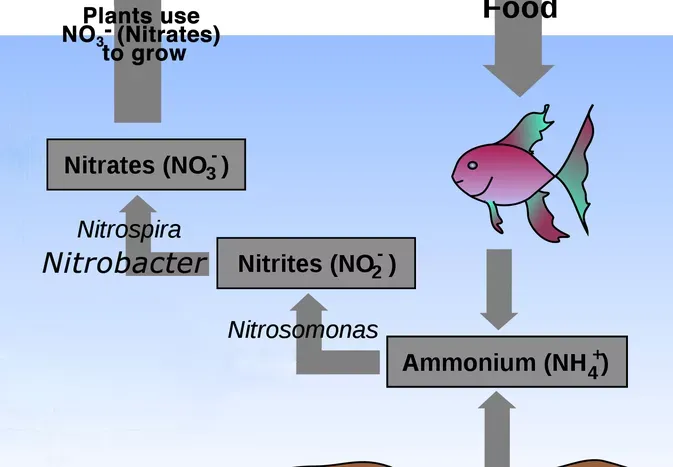What Is the Nitrogen Cycling Process in a Saltwater Aquarium?
Updated on 05/26/24

Embark on a Nitrogenous Odyssey: Delving into the Cycling Process in Saltwater Aquariums
Welcome to the fascinating world of saltwater aquariums, where the nitrogen cycle reigns supreme as the cornerstone of a thriving aquatic ecosystem. This intricate natural process ensures the removal of toxic nitrogenous waste, creating a healthy and balanced environment for your marine inhabitants. Prepare to immerse yourself in a comprehensive exploration of the nitrogen cycling process, its significance, and practical applications for maintaining a pristine saltwater aquarium.
The Nitrogen Cycle: A Symphony of Transformations
Imagine a bustling city where waste accumulates relentlessly, potentially leading to chaos and toxicity. In a saltwater aquarium, nitrogenous waste, primarily in the form of ammonia, plays the role of this waste. The nitrogen cycle, like an efficient waste management system, orchestrates a series of biochemical transformations to convert this toxic substance into harmless forms.
The nitrogen cycle unfolds in a sequential dance of microbial activity:
1. Ammonia (NH3): The initial stage involves the production of ammonia (NH3) by fish, invertebrates, and the decomposition of organic matter. Ammonia is a highly toxic substance, even in trace amounts.
2. Nitrite (NO2-): Specialized bacteria, known as Nitrosomonas, colonize surfaces within the aquarium and convert ammonia into nitrite (NO2-). Nitrite is less toxic than ammonia but still harmful to aquatic life in elevated concentrations.
3. Nitrate (NO3-): A different group of bacteria, Nitrobacter, then takes over, transforming nitrite into nitrate (NO3-). Nitrate is the least toxic form of nitrogen and can be tolerated by marine organisms at higher levels.
4. Denitrification: The final act of the nitrogen cycle occurs in anoxic (oxygen-depleted) zones, such as the deep sand bed or within live rock. Here, specialized bacteria convert nitrate back into nitrogen gas (N2), which escapes into the atmosphere, completing the cycle.
The Importance of a Balanced Nitrogen Cycle
A well-established nitrogen cycle is paramount for maintaining a healthy saltwater aquarium. Uncontrolled ammonia and nitrite levels can lead to stress, disease, and even mortality among your marine inhabitants. Nitrate accumulation, while less toxic, can contribute to algal blooms and disrupt the overall balance of the ecosystem.
Regular monitoring of ammonia, nitrite, and nitrate concentrations is essential to ensure the nitrogen cycle is functioning efficiently. Test kits and electronic meters provide reliable measurements, allowing you to make informed decisions regarding water changes, filtration, and biological supplementation.
Practical Applications for a Thriving Aquarium
Understanding the nitrogen cycle empowers you to create and maintain a flourishing saltwater aquarium:
1. Cycling a New Aquarium: Before introducing live animals, it is crucial to establish a stable nitrogen cycle. This process typically takes several weeks, involving regular ammonia dosing and monitoring until beneficial bacteria populations are well-established.
2. Water Changes: Regular water changes remove accumulated nitrate and replenish essential elements. The frequency and volume of water changes depend on the aquarium's bioload, filtration capacity, and the desired nitrate level.
3. Biological Filtration: Live rock, biological media, and deep sand beds provide ample surface area for beneficial bacteria to colonize, promoting efficient nitrogen removal. Maintaining a clean and well-maintained biological filter is key to a healthy nitrogen cycle.
4. Biological Supplements: In some cases, introducing commercially available bacterial supplements can accelerate the cycling process or replenish beneficial bacteria populations after disturbances.
Case Studies: Lessons from Real-World Aquariums
1. The Case of the Ammonia Spike: A sudden increase in ammonia levels can indicate a disruption in the nitrogen cycle, such as overfeeding, overcrowding, or a malfunctioning filter. Prompt action, including water changes and ammonia removal products, is crucial to prevent fish loss.
2. The Nitrate Dilemma: Elevated nitrate levels can lead to excessive algae growth and stunted coral growth. Implementing nitrate-reducing media, increasing water changes, or adding macroalgae that absorb nitrate can effectively control nitrate levels.
3. The Power of Denitrification: A well-established deep sand bed or dedicated nitrate reactor can significantly reduce nitrate levels through denitrification. This process creates a more natural and stable environment for marine organisms.
Conclusion: A Foundation for Success
The nitrogen cycling process forms the bedrock of a thriving saltwater aquarium. By understanding and actively managing this essential ecosystem service, you can create a pristine aquatic environment where your marine inhabitants flourish. Regular monitoring, appropriate filtration, and a proactive approach to water management will ensure a stable nitrogen cycle, promoting the health, longevity, and beauty of your saltwater aquarium.
Remember, the nitrogen cycle is a living, breathing process that requires your care and attention. Embrace its complexities, and you will be rewarded with a vibrant and thriving underwater paradise.
Explore More Pets

Freshwater Aquarium Filters
How to Deal With Cloudy Aquarium Water

Saltwater Aquarium Filters
How Do You Remove Chloramines From Tap Water?

Freshwater Aquariums & Habitat
Can I Keep My Koi Fish Inside?

Saltwater Aquariums & Habitat
14 Best Floating Plants for Your Aquarium

Freshwater Fish Health
How to Treat Ich on Freshwater Fish

Saltwater Fish Health
Fin Rot in Aquarium Fish

Freshwater Aquarium Filters
How to Do Aquarium Water Changes

Saltwater Fish Health
How Do Fish Get Parasites?
